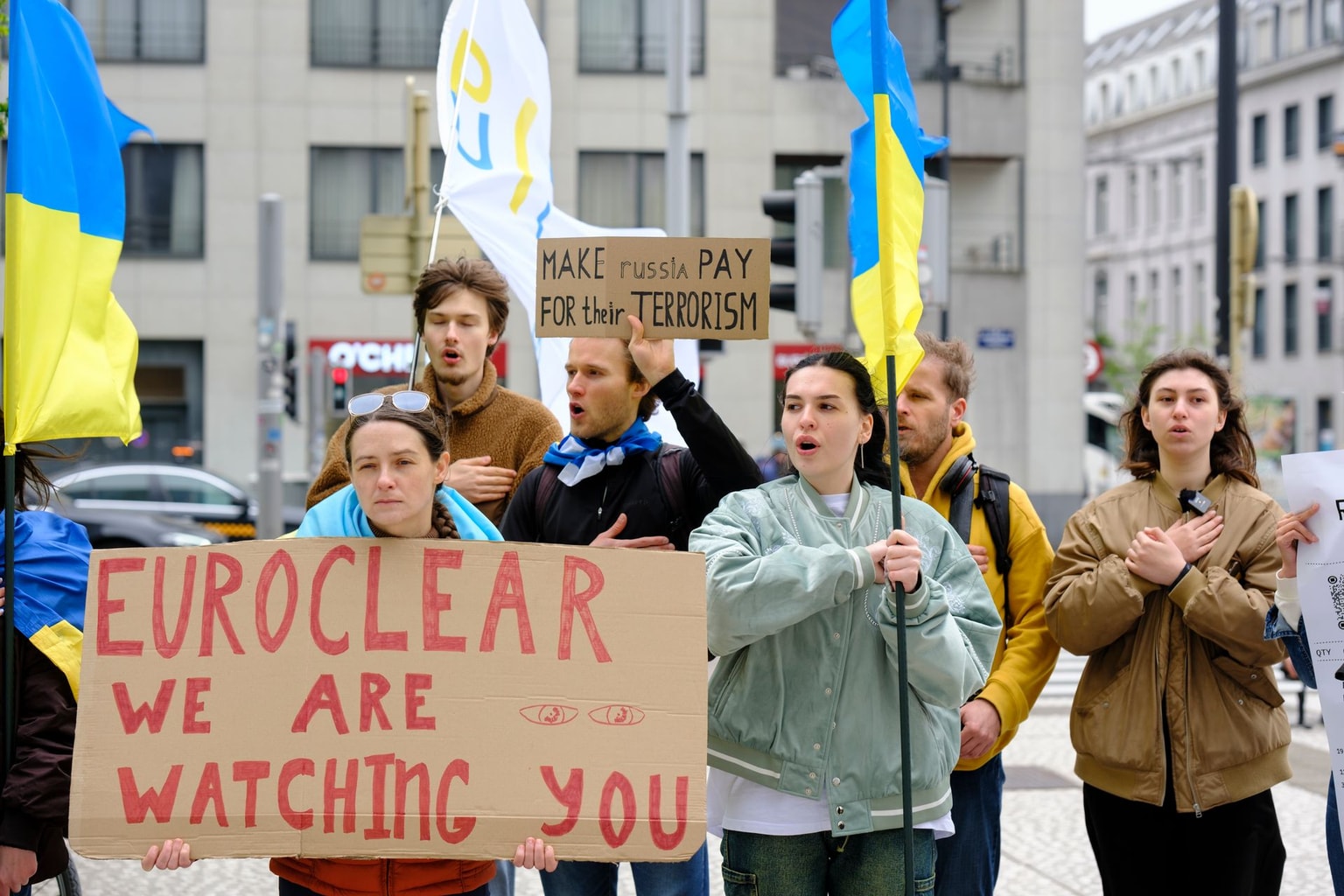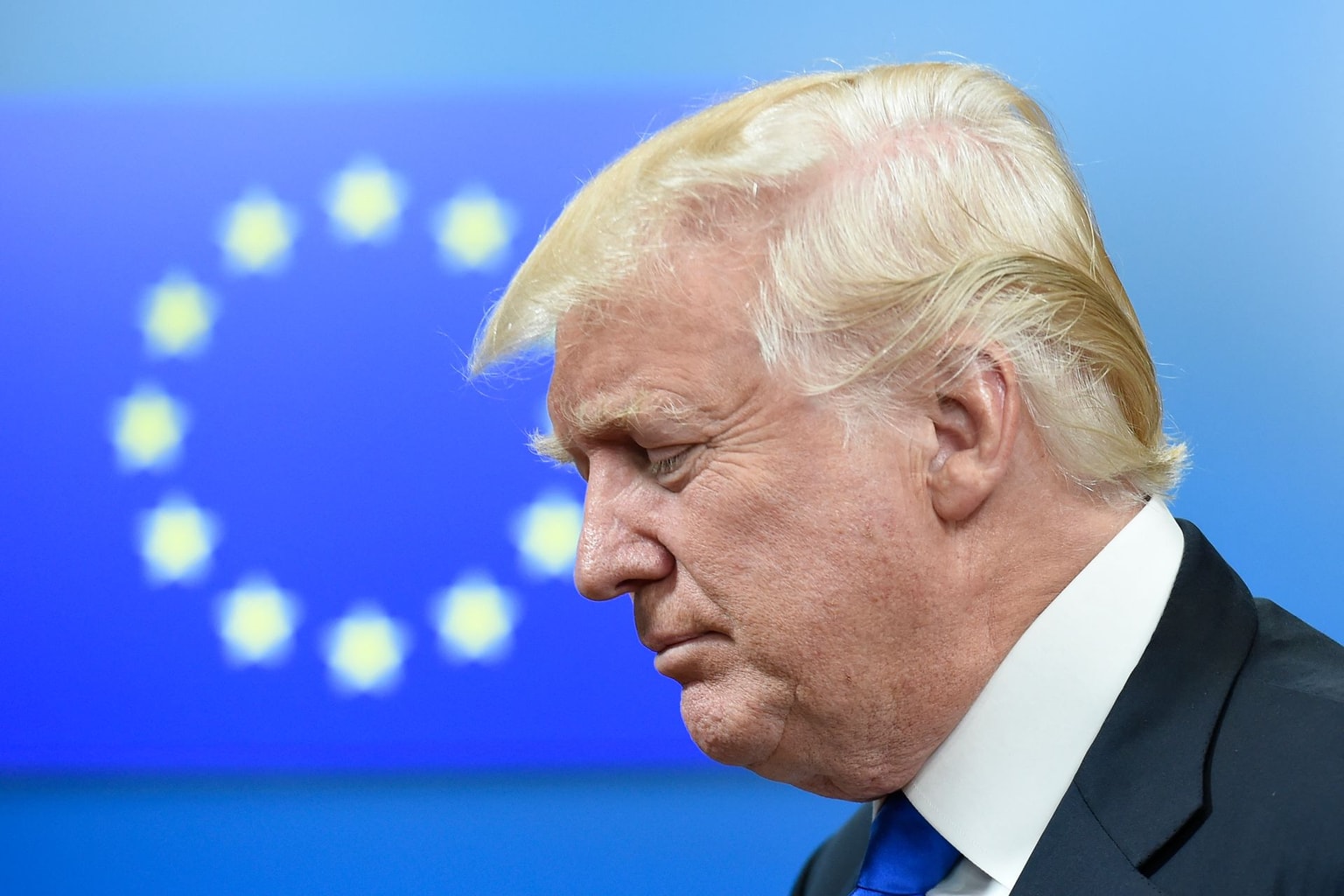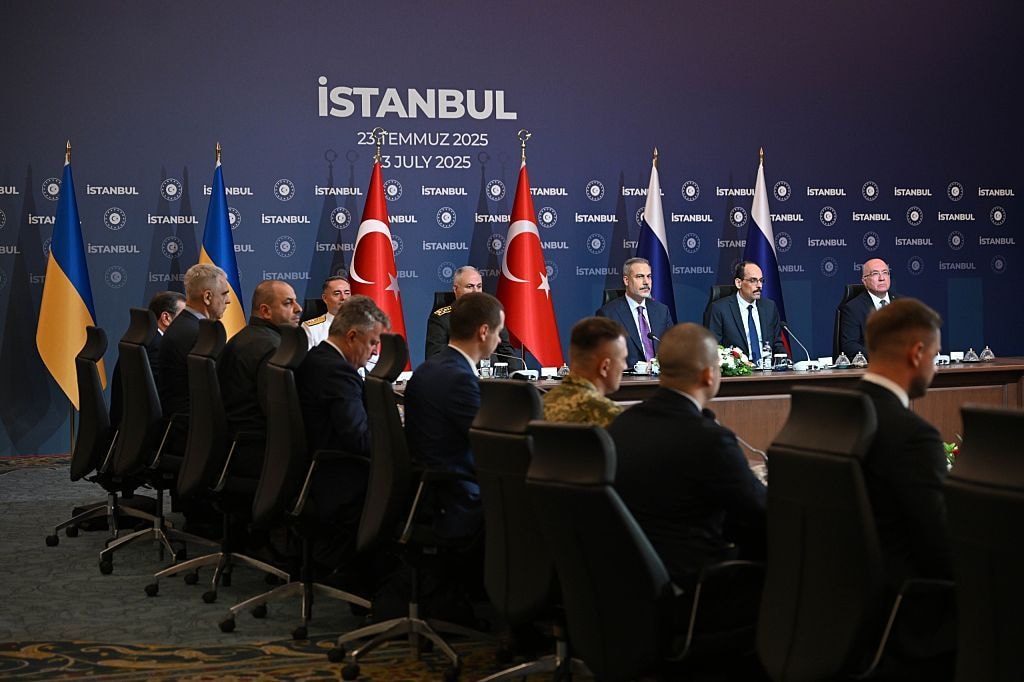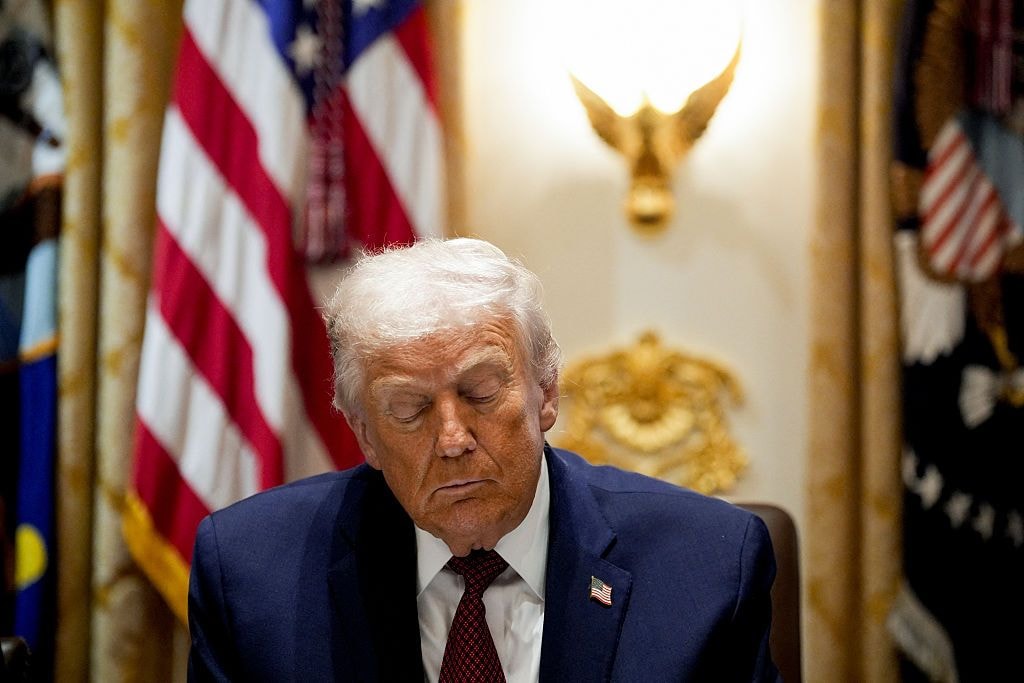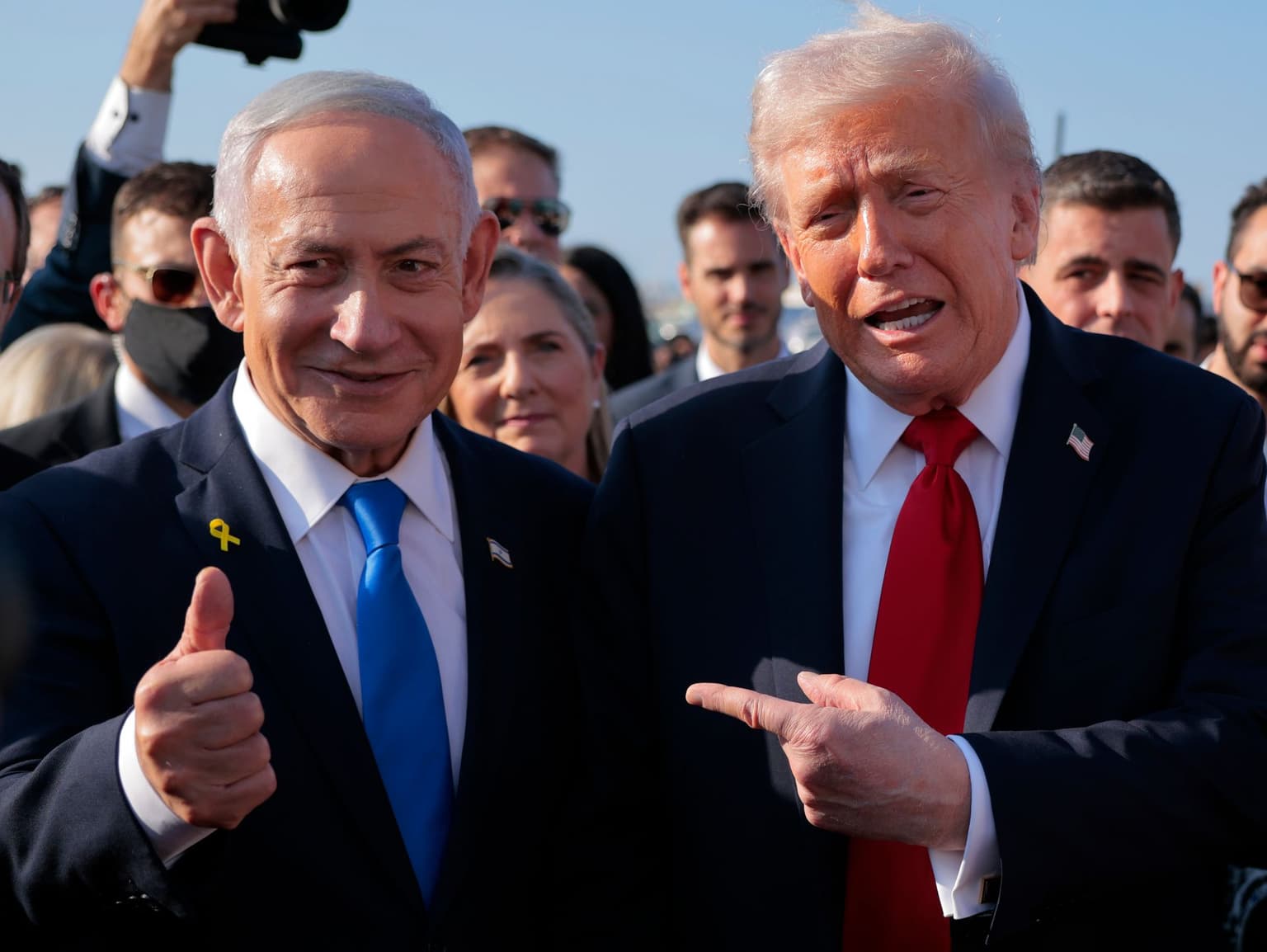
Trump's two wars: Why diplomacy worked in Gaza but not in Ukraine
U.S. President Donald Trump speaks to Israeli Prime Minister Benjamin Netanyahu at Ben Gurion International Airport before boarding his plane to Sharm El-Sheikh, on Octю 13, 2025 in Tel Aviv, Israel. (Chip Somodevilla/Getty Images)
U.S. President Donald Trump's success in brokering the Oct. 9 ceasefire deal between Israel and Hamas has been praised worldwide.
What seems to be a diplomatic victory in the Middle East stands in sharp contrast with Trump's failure to negotiate a ceasefire in Eastern Europe.
One reason for the difference is objective. Trump has far more leverage over Israel than over Russia, while Hamas has been weakened so much that it had no choice but to agree to a ceasefire.
Another reason, experts say, is subjective — Trump's sudden willingness to apply leverage to Israel and his reluctance to apply it to Russia.
The Gaza peace deal showed that peace is achievable when there is political will — something that has been notably lacking in Trump's peace efforts in Ukraine.
"The U.S. just doesn't have the same degree of leverage over Russia as it does over Israel," Jenny Mathers, a lecturer in international politics at the U.K.'s Aberystwyth University, told the Kyiv Independent.
"The main point of leverage now is the amount and nature of military support that the U.S. provides to Ukraine, but that has been limited first by (ex-U.S. President Joe) Biden's caution and fear of Russia escalating either to use nuclear weapons or to expand the conventional war beyond Ukraine's borders, and more recently by Trump's attitude."
Gaza peace plan
The most recent war in Gaza began on Oct. 7, 2023, when Hamas, an Iranian proxy designated as a terrorist organization by the U.S. and the EU, invaded Israeli territory, massacred 1,195 people, and took 251 people hostage. Israel responded by invading the Gaza Strip.
Two years later, Israel and Hamas agreed to a ceasefire deal brokered by the U.S. and a number of regional actors.
On Oct. 13, Hamas released all 20 living hostages being held in Gaza, and Israel released just under 2,000 Palestinian prisoners.

As part of the deal, Israel has started a gradual withdrawal from the Gaza Strip. Yet, the ceasefire doesn't envision Israel's full withdrawal from the strip.
The subsequent peace deal, promoted by Trump, allegedly lays the groundwork for the demilitarization of the Gaza Strip and the deployment of an international peacekeeping force, with Hamas relinquishing power to Palestinian technocrats under international supervision. According to the plan, Israel is expected to withdraw from most of the Gaza Strip except for a buffer zone along the border.
Hamas accepted the ceasefire but has not publicly agreed to the terms of Trump's potential peace deal.
Different leverage
One difference between the wars in Gaza and Ukraine is that U.S. leverage over Israel is stronger than over Russia. Washington, Israel's main military ally, has supplied it with crucial weapons and shared intelligence.
"President Trump has more leverage on Israel than on Russia," William Wohlforth, a professor focusing on international relations at Dartmouth College, told the Kyiv Independent. "Yes, he has leverage on Russia he has not used, but, even so, objectively the U.S. influence on Israel is far, far greater."
"Trump's leverage over (Israeli Prime Minister Benjamin) Netanyahu is based on strong institutional relations between the U.S. and Israel and close personal ties between the two men," Neil Quilliam, a Middle East expert at Chatham House, told the Kyiv Independent. "He can pressure Netanyahu as much as he wishes and, at the same time, point to all the times he has supported Israel to counter criticism."
Mathers argued that "the U.S. supplies Israel with weapons and is a longtime ally of Israel, with a large and vocal pro-Israel lobby in the U.S., and support for Israel has been a pillar of U.S. post-World War II foreign policy."
"On the one hand, this means that successive U.S. administrations have felt the pressure to support Israel in public, almost no matter what," she added. "On the other hand, it means if Washington really loses patience with Israel and conveys that message effectively, Israel needs to pay attention."
In contrast, the U.S. leverage over Russia is limited.

Neither Western sanctions against Moscow nor military aid to Ukraine have pushed Russia towards peace.
Unlike Israel, Moscow is not an ally dependent on Washington, and trade between the U.S. and Russia is limited, making economic sanctions ineffective.
Political will in Gaza peace efforts
Another important factor is Trump's willingness to use the leverage that he has both in Ukraine and in the Middle East.
Until recently, Trump had mostly sided with Israel and had been reluctant to pressure Netanyahu to end the war.
Before he took office on Jan. 20, Trump's team brokered the Jan. 15 ceasefire deal between Israel and Hamas in Gaza.
However, the agreement quickly unraveled as Israel and Hamas accused each other of violating it. Israel resumed military action in March.
Israel's key military objective has been to eliminate Hamas to prevent attacks similar to the one carried out in October 2023.
"The main challenge in ending the Gaza War has been Israel's unwillingness to do so," Timo Stewart, a Middle East expert at the Finnish Institute of International Affairs, said.
"Netanyahu has derailed previous attempts at an agreement and ultimately sabotaged the January-March 2025 ceasefire. At least part of the motivation has been to keep his government intact."
Analysts say that Netanyahu was afraid that his far-right allies would quit the government and prompt his resignation.
Aron Lund, a Middle East analyst at Century International, said that previously "very little was done by the United States to make Israel comply with U.S. policy."
"That was true under both Biden and Trump, and it's what led to the collapse of the previous ceasefires, in 2023 and earlier this year," he told the Kyiv Independent. "Israel simply decided that it was time to go back to war, and the United States stood aside and let it happen."
The situation changed in September, when international condemnation of Israel's military action in Gaza grew, and Israel conducted an airstrike against Hamas leaders in Qatar, a U.S. ally.
"One of the main reasons why Trump went hard against Netanyahu was the Sept. 9 attack on Qatar," David Butter, a Middle East expert at Chatham House, told the Kyiv Independent. "Trump wasn't consulted or forewarned, and the attack threatened to poison U.S. relations with its key Gulf Arab allies, countries where the Trump family has huge financial investments."
Stewart argued that "ultimately, this ceasefire was reached because Trump was both able and willing to pressure Israel."
Trump's peacemaking efforts benefited from the fact that Hamas has been severely weakened. Arab countries and Turkey have also used their leverage to persuade the terrorist group.
"Israel had weakened Hamas, as well as Iran and its proxies, to such a degree as to help force Hamas to accept at least the first stage of the deal, releasing hostages," Wohlforth said. "Russia's war on Ukraine, by contrast, is more balanced, with neither side gaining that kind of decisive advantage."
Lack of political will in Ukraine
In Ukraine, political will — or lack thereof — has also been part of the equation.
Trump has pressured Ukraine to negotiate with Russia, and President Volodymyr Zelensky has agreed to an unconditional ceasefire — a move that the Kremlin rejected.
Trump has also regularly threatened to sanction Russia and its trading partners in an effort to make it agree to a ceasefire or peace deal.
In most cases, no action followed the threats.
One notable exception is Trump's decision to impose a 25% tariff on India in August over its purchases of Russian oil. The tariff has not led to a decrease in India's imports of Russian oil, however.
Meanwhile, Trump has failed to impose a tariff on China, another big buyer of Russian oil, and effectively scrapped a congressional bill that would impose 100% tariffs on countries that buy Russian oil and other products.
Nor has there been any progress on the Senate bill to sanction Russia's shadow oil tanker fleet.
Trump has taken some minor steps to continue U.S. military supplies to Ukraine.
After halting U.S. military aid for Ukraine twice, Trump announced in July an initiative under which other NATO members would purchase U.S.-made weapons for Ukraine.
However, NATO military aid to Ukraine fell in July and August despite the scheme, according to an Oct. 14 report by the Kiel Institute.
U.S. Vice President JD Vance said in September that the U.S. was "looking at" providing Kyiv with Tomahawk cruise missiles, which have an operational range between 1,600 and 2,500 kilometers. However, no decision on the issue has been made so far.
"The leverage the U.S. and Western allies do have is the ability to increase the cost of the war to Moscow by supplying weapons and aid to Ukraine, but this did not get (Russian President Vladimir) Putin to stand down for two years under Biden, and slipped in strength under Trump," Richard Betts, professor emeritus of war and peace studies at Columbia University, told the Kyiv Independent.
"If Trump follows through on his recent threat to provide Tomahawk cruise missiles to Ukraine, this would represent a more radical shift in support for Ukraine."

